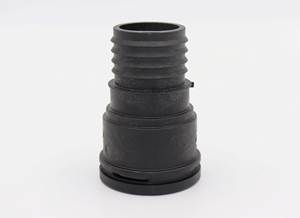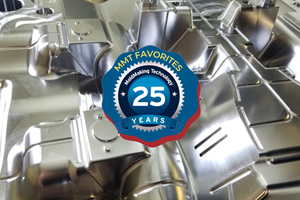From the Field: Spotting Press Aids Extensive Mold Inspection at BMW
Tool designers at a BMW factory work on the automotive future with the right spotting press installed to extensively check molds.
Share
Read Next
With the introduction of new models on the market by BMW next year, the company will leave its mark not only as concerns propulsion systems. The Premium brand is exploring new ground with regard to vehicle structure and vehicle body, too: the overall construction of some models – from the carbon fiber-reinforced plastic passenger compartment to injection molded body parts or parts manufactured with RTM technology – will soon be implemented for the first time in series-production vehicles.
This brings about new challenges in toolmaking. “We manufacture molds and jet molds as well as molds for the Resin Transfer Mold (RTM) process,” says Josef Puchner Toolmaking Manager at the BMW factory in Landshut.
“In order to keep idle time during production as short as possible, and so that only well-engineered and fully functioning molds are used on presses and injection molding machines, each mold goes through an extensive inspection procedure, during which even final optimisations are carried out. This applies both to new molds manufactured in-house and to purchased ones, as well as to repaired molds. In this way we can guarantee a very high availability of our molds.”
Only what makes chips is productive and thus creates added value – this not necessarily correct idea is still widespread today. Therefore, it is clearly not easy to justify the purchase of a spotting press based on productivity or profitability. But what is the most precise lathe, or the most accurate machining centre for, if it is not possible to check molds closely under process conditions? With the purchase of an comprehensively equipped spotting press, BMW sets a benchmark – for sub-suppliers, too. Those who want to deliver mostly to OEMs in the future will do well not to save at the wrong end. If suppliers want to get lucrative orders, a good spotting press will soon become an absolute must not only in the automotive industry.
From a long time already, the Landshut factory has been relying on a Millutensil press for tryout, a Mil 306 “Blue Line” press, one of the biggest models of the Italian manufacturer's catalogue.
“However, the new molds of the 4 m class with weight generally between 40 and 100 t were too big for this press,” explains Puchner. “In addition, we wanted to use the tryout press beyond its classic duty range – it had to be for us a master press and calibration device, too.”
Of course the press should be suitable for use with all relevant mold categories. It should enable a quick, simple and comfortable setup with maximum accuracy and process safety, as well as an ergonomic work. And, in addition to mere spotting, it should be possible to carry out extensive tests on the press. “At the beginning we wanted to reproduce exactly the same relevant characteristics of a production press on the spotting press – certainly not at the price of a production press.”
We consulted the various press manufacturers, but the broad specifications of a production press fitted no existing spotting press. “Besides the structural advantages and the outstanding mechanical characteristics of presses, at Millutensil we found the openness, the courage and also the enthusiasm to implement such a project together,” says Puchner. Last but not least, this new press also implied going beyond certain limits – it was used in a much more extensive way than “just” as a spotting press.
Comprehensive FEM calculations were carried out, and design was focused on very high press robustness and accuracy. The result was a completely new Model, the Mil 408. The 4-column press, which gets its 500 t closing force from four cylinders, is also extremely compact – considering the crane height, this is an important criterion in newly built shops, too.
In addition, the press experts at Millutensil scaled the well-known options of the manufacturer's smaller spotting presses for optimal mold handling: the mold can be moved out the press laterally, enabling working in an ergonomically ideal position. The punch can be rotated automatically by 180° and also put in a comfortable working position for the toolmaker upstream the press. Therefore, the tiring and dangerous work above head in the press which so far has been largely inevitable, especially in case of big molds, belongs to the past: the toolmaker has all relevant areas in sight, and thus can check very quickly and accurately where rework is still needed, and can take the necessary measures.
But the Mil 408 press offers much more than a “classic” spotting press: the molds can be brought to working temperature – which is essential for exact statements about precision and dimensional accuracy.
Hydraulic lines for the actuation of all slides and core pullers, feeding lines for cooling or the possibility to create a vacuum are also integrated. The comprehensive interfaces for sensory test, the media feeds and the wiring are connected automatically though hydraulically positionable Stäubli multi-couplings.
Resin injection and therefore a full production functionality can also be theoretically implemented – this, however, was not the toolmaker's intention: “On the one hand, we didn't want to worsen the high accuracy of the press in its calibration function due to the accompanying circumstances of production such as dirt and wear,” Puchner explains. “On the other hand, we also don't want to whet the appetites of production managers – if the press is equipped for production even just once, experience shows that it then will be used for that purpose, too, so it is no longer available for its actual tasks.”
All functions can be controlled in a centralised and intuitive way by means of the Siemens touch panel developed specifically for the needs of motor vehicle manufacturers. In this respect, as regards data, too, attention was paid to consistency and a high automation degree. Once entered into the control system, the molds are stored permanently in it.
In this way the configuration is already available when a mold is to be repaired or changed later on.
“The press is for us almost like a mold testing station – we can access very easily the condition, values and parameters that the mold had upon delivery. So causes of failures can be detected very quickly. The press is also equipped with high efficiency tear cylinders, which also have a 500 t capacity like our production presses. So far, however, we had to use them only once,” notes Puchner.
Moreover, there's no time for repairs in production: the lot sizes are relatively small, in case of failure the machine is simply shut down, which – thanks to the ingenious mold concept at BMW - is linked to a very low cost. Repairs and tests are then carried out during toolmaking – in this way production is efficiently relieved.
From an organisational point of view, the BMW toolmaking is integrated directly into the purchasing department. Therefore, the molds manufactured by sub-suppliers, too, go through Puchner's department. And also about the Mil 408: “Here, too, the press with the possibilities it offers has proven its value”, he explains. “The Mil 408 is perfect for our needs. Therefore, we have already ordered two more spotting presses of this type for our factory in Leipzig.”
It goes without saying that, besides maximum accuracy and ergonomic design, safety aspects, too, are exhaustively taken into consideration in Millutensil spotting presses. For example, in the Mil 408 press a system developed by Millutensil checks if tables move in an exact parallel way towards each other upon press closure. A hammer forgotten on the mold, therefore, cannot cause any big damage upon press closure. In case of even minimum deviation from the parallel position due to any obstacle, the closure process is interrupted immediately. This guarantees the reliable avoidance of any damage of mound and press.
BMW factory in Landshut: In the BMW factory of Landshut, approximately 3,000 employees manufacture motor and chassis frame components made of light metal casting, inside and outside plastic components as well as drive shafts and replacement engines, which are delivered all over the world to almost all car and motor factories of the BMW Group. Molds, jet molds and RTM molds are used to manufacture any kind of model. Especially as regards new models, here a considerable expertise has been developed for RTM and injection molded parts for passenger compartments and shells. The production area Exterior Plastic received the “Industrial Excellence Award” as “best factory of the year 2012.”
www.bmw-werk-landshut.de
www.millutensil.com
Related Content
MMT Chats: Solving Schedule and Capacity Challenges With ERP
For this MMT Chat, my guests hail from Omega Tool of Menomonee Falls, Wisconsin, who share their journey with using enterprise resource planning (ERP)—and their people—to solve their schedule and capacity load monitoring challenges.
Read MoreIt Starts With the Part: A Plastic Part Checklist Ensures Good Mold Design
All successful mold build projects start with examining the part to be molded to ensure it is moldable and will meet the customers' production objectives.
Read MoreHow to Harness 3D Scanning for Mold Tool Repairs
3D scanning supports the repair of molds with no history, drawings or design files.
Read MoreLeading Mold Manufacturers Share Best Practices for Improving Efficiency
Precise Tooling Solutions, X-Cell Tool and Mold, M&M Tool and Mold, Ameritech Die & Mold, and Cavalier Tool & Manufacturing, sit down for a fast-paced Q&A focused on strategies for improving efficiencies across their operations.
Read MoreRead Next
Are You a Moldmaker Considering 3D Printing? Consider the 3D Printing Workshop at NPE2024
Presentations will cover 3D printing for mold tooling, material innovation, product development, bridge production and full-scale, high-volume additive manufacturing.
Read MoreHow to Use Continuing Education to Remain Competitive in Moldmaking
Continued training helps moldmakers make tooling decisions and properly use the latest cutting tool to efficiently machine high-quality molds.
Read MoreHow to Use Strategic Planning Tools, Data to Manage the Human Side of Business
Q&A with Marion Wells, MMT EAB member and founder of Human Asset Management.
Read More
















